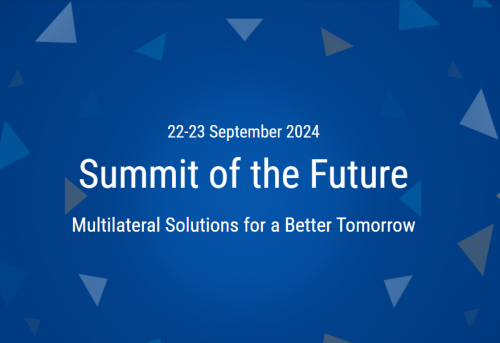Sustainable Peace
The Summit of the Future, September 2024
The Summit of the Future is a once-in-a-generation opportunity to enhance cooperation on critical challenges and address gaps in global governance, reaffirm existing commitments including to the Sustainable Development Goals (SDGs) and the United Nations Charter, and move towards a reinvigorated multilateral system that is better positioned to positively impact people’s lives.
2024 September - Pact for the Future: An action-oriented Pact for the Future will be endorsed by Heads of State/Government at the Summit, showcasing global solidarity for current and future generations.
2022-2024 - Summit of the Future: Having welcomed the submission of Our Common Agenda, the General Assembly passed a resolution in 2022 (A/RES/76/307) to hold the Summit of the Future on 22-23 September 2024. Practical consultations on preparations for the Summit began in February 2023 and a Ministerial meeting took place. The Summit of the Future will build upon the SDG Summit and breathe new life into the multilateral system so that it can deliver on the promises of the United Nations Charter and the 2030 Agenda.
2023 - SDG Summit: Marking the mid-point of the implementation of the 2030 Agenda, the SDG Summit in 2023 convened on 18-19 September 2023 to “mark the beginning of a new phase of accelerated progress towards the Sustainable Development Goals”.
2021 - Our Common Agenda: The Secretary-General responded to the call with Our Common Agenda, a wake-up call to speed up implementation of the SDGs as well as recommendations to address strategic gaps in global governance arrangements. It called for a Summit of the Future to forge a new global consensus on multilateral solutions to current and future problems.
2020 - UN 75 Declaration: In the midst of the COVID-19 pandemic, Member States issued the UN75 Declaration that included 12 overarching commitments along with a request that the Secretary-General report back to the General Assembly with recommendations to address current and future challenges.
How to sustain peace: to adopt peacebuilding policies and implement before, during and after conflict.
SDG Secretariat under the Government of Georgia has elaborated the SDG Country Nationalization Document during 2015-2017. All 17 Goals of the SDG are made as a priority for the country.
A watershed in the history of understanding and addressing Peace
Two Resolutions (S/RES/2282; A/RES/70/262) adopted in April 2016 by the Security Council and General Assembly of the United Nations (UN) were a watershed in the history of understanding and addressing Peace.
Before 2016 the PEACE was understood as a supplementary process of the post-conflict stage/situation. Although, the UN Resolutions formulated sustaining peace as “a goal and process aimed at preventing the outbreak, escalation, continuation and recurrence of conflict”, thus obliging Member States to adopt and implement peacebuilding policies before, during and after conflict.
Downloads:
Before 2016:
Before 2016 the PEACE was understood as a supplementary process of the post-conflict stage/situation:
Ø Three high-level review processes of 2015:
v THE CHALLENGE of SISTAINING PEACE - The Report, the Advisory Group of Experts's review of the Peacebuilding Architecture, (29 June 2015);
v UNITING OUR STRENGTHS FOR PEACE - The Report of the High-Level Panel on Peace Operations, Uniting our Strengths for Peace – Politics, Partnership and People, (16 June 2015);
Ø The 2030 Agenda for Sustainable Development - The General Assembly Resolution, (25 September 2015);
Ø IN LARGER FREEDOM - United Nations, General Assembly, In larger freedom: towards development, security and human rights for all: report of the SecretaryGeneral, A/59/2005 (21 March 2005);
Ø A MORE SECURE WORLD - United Nations, General Assembly, A More Secured World: our shared responsibility, a report of the High-Level panel on threats, challenges, and change, A/59/565 (2 December 2004);
Ø PREVENTION of ARMED CONFLICT - United Nations, General Assembly, Prevention of Armed Conflict, report of the Secretary-General, A/55/985 (7 June 2001);
Ø AN AGENDA FOR PEACE - United Nations, General Assembly, An Agenda for Peace: preventive diplomacy, peacemaking and peace-keeping, a report of the Secretary-General, A/47/277 -S/24111 (17 June 1992).
Downloads:
After 2016:
After 2016 the PEACE is understood as a goal and process aimed at preventing the outbreak, escalation, continuation and recurrence of conflict to be adrressed before, during and after.
Ø Progress towards the Sustainable Development Goals (SDG) - Reports of the Secretary-General: 2017, 2016, ...
Ø Report on “UN Activities in Support of Mediation” - United Nations, A/72/115, (June, 2017);
Ø Strengthening the Role of Mediation in the Peaceful Settlement of Disputes, Conflict Prevention and Resolution - United Nations, General Assembly A/RES/70/304.
Ø Guidance on Gender and Inclusive Mediation Strategies - United Nations, (March, 2017)
Ø Conflict Prevention and post-conflict peacebuilding - United Nations, Security Council Resolution 2282 (2016) S/RES/2282, (27 April 2016)





